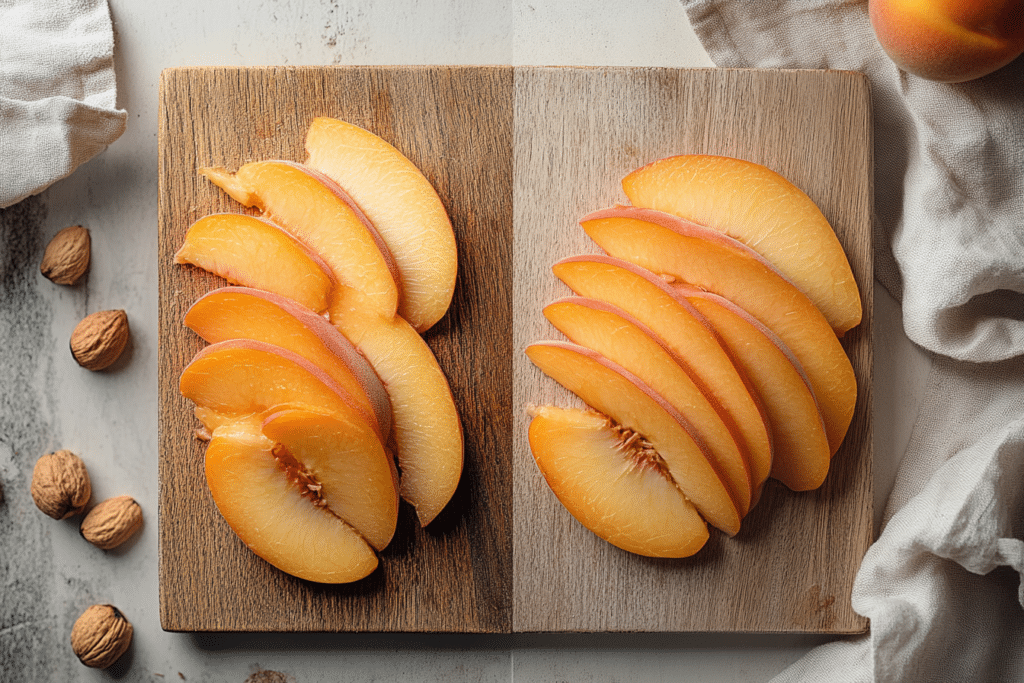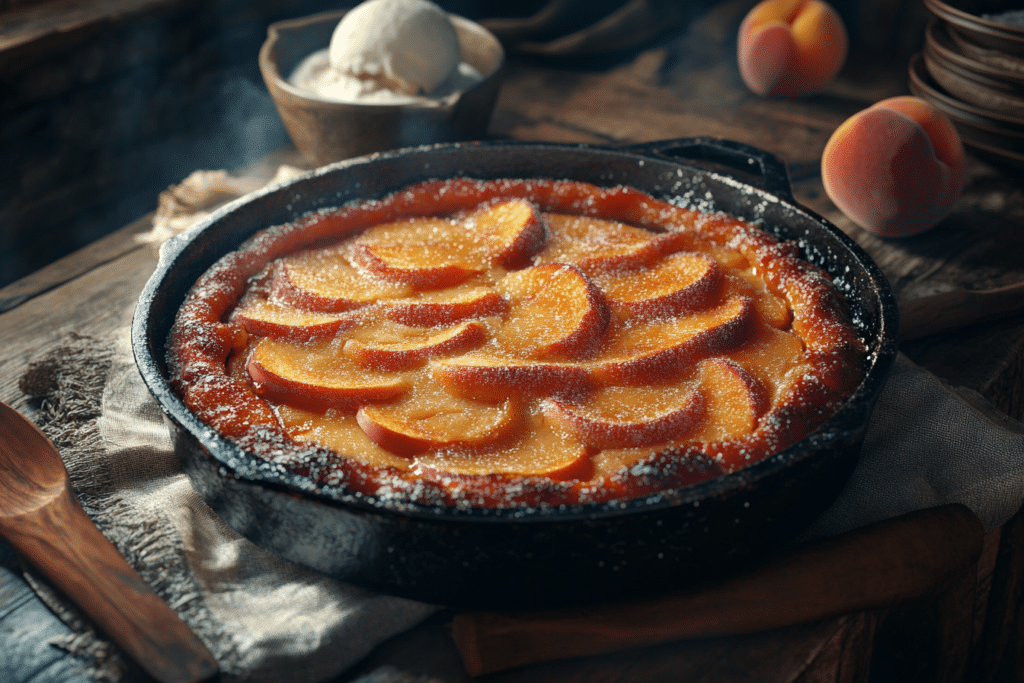1. Introduction
Peach cobbler is a timeless dessert loved for its sweet, juicy filling and buttery topping. While traditional recipes often call for peeling peaches, many home bakers now ask: What happens if you don’t peel peaches for cobbler?
Leaving peach skins on can save preparation time, reduce food waste, and even add a touch of nutrition. However, it can also impact the texture, flavor, and presentation of the final dish. This article will explore whether peeling peaches is necessary, the benefits of leaving them unpeeled, and the drawbacks to consider.
By the end, you’ll have a complete understanding of the pros and cons, as well as tips on how to make peach cobbler with or without peeled peaches. Whether you’re looking for a quick and rustic recipe or aiming for a smooth and refined version, this guide has you covered.
2. What Happens If You Don’t Peel Peaches for Cobbler?
When preparing peach cobbler, one of the most common questions is: What happens if you don’t peel peaches for cobbler? While peeling peaches is a tradition in many recipes, modern cooks are now experimenting with leaving the skins on. Let’s explore why peeling has been the norm and what happens when you skip this step.
2.1 Why Do Traditional Recipes Recommend Peeling Peaches for Cobbler?
For generations, peeling peaches has been the standard method for recipes like cobblers, pies, and crisps. Here’s why:
- Texture: Peach skins can add a slight chewiness, which some bakers feel disrupts the smooth texture of the filling.
- Presentation: Peeled peaches look uniform and soft, creating a more refined appearance.
- Flavor: Some believe the peach skins can introduce a slightly earthy or bitter flavor, which might not complement the sweetness of the cobbler.
To peel peaches quickly, traditional methods include:
- Blanching: Boil peaches for 30 seconds, transfer to ice water, and slip off the skins.
- Paring Knife: Use a knife to carefully peel ripe peaches.
While peeling is effective, it’s time-consuming and can lead to waste, sparking the question: What happens if you don’t peel peaches for cobbler?
2.2 What Happens If You Don’t Peel Peaches for Cobbler?
In recent years, many bakers and food enthusiasts have embraced a more rustic approach to cooking. Leaving the skins on peaches has become a popular option, especially for cobblers. Here’s why:
- Time-Saving: Skipping the peeling process reduces prep time significantly.
- Texture Appeal: Some enjoy the slight chewiness that peach skins add, feeling it enhances the dessert’s character.
- Natural Appearance: Unpeeled peaches give the cobbler a vibrant, rustic look with hints of pink and orange from the skins.
The shift toward unpeeled peaches has made cobbler recipes more accessible and appealing for home bakers looking to simplify their cooking process.
3. What Happens If You Don’t Peel Peaches for Cobbler? Key Effects
Leaving the skins on peaches for cobbler is a decision that affects several aspects of the dessert, including texture, flavor, and appearance. If you’ve ever wondered, “What happens if you don’t peel peaches for cobbler?”, here’s a detailed breakdown of what to expect.
3.1 How Does the Texture Change If You Skip Peeling Peaches for Cobbler?
The texture of your cobbler changes noticeably when the peach skins are left on:

- Softened Skins: During baking, the heat softens the peach skins, making them less noticeable than they are when raw.
- Chewiness: Despite softening, the skins retain a slight chewiness that some people love for its rustic feel, while others may find it distracting.
- Juice Retention: Peach skins help hold the fruit’s juices in place, preventing the filling from becoming overly mushy.
The skins’ subtle texture can add character to a cobbler. However, if a perfectly smooth filling is your goal, peeling the peaches may still be preferable.
3.2 What Happens to the Flavor If Peaches Are Left Unpeeled for Cobbler?
If you skip peeling peaches for cobbler, the flavor profile may have a slight but noticeable difference:
- Earthy Notes: Peach skins can introduce a mild earthiness, which contrasts beautifully with the sweet and tart notes of the peach flesh.
- Robust Flavor: Leaving the skin on adds depth, making the cobbler taste richer and less one-dimensional.
- Sweeter Cobblers: Because skins hold juices better, unpeeled peaches may result in a slightly sweeter and more flavorful filling.
For most people, the impact on flavor is minimal. However, certain peach varieties with tougher skins might contribute a hint of bitterness.
3.3 Will the Appearance Be Different If You Don’t Peel Peaches for Cobbler?
The appearance of peach cobbler changes depending on whether the peaches are peeled or not:

- Rustic Appeal: Unpeeled peaches add vibrant hues of pink, orange, and red, enhancing the cobbler’s visual appeal. This is particularly noticeable in homemade, rustic-style desserts.
- Less Refined Look: For formal occasions, peeled peaches provide a smoother, more uniform look.
Whether or not you peel peaches comes down to personal preference. Unpeeled peaches make the cobbler look more natural and colorful, while peeled peaches deliver a more polished presentation.
3.4 Does It Save Preparation Time?
One of the biggest advantages of leaving peach skins on is the time it saves:
- Peeling Peaches: Blanching, cooling, and peeling peaches can add an extra 10–15 minutes to prep time.
- Skipping Peeling: Simply washing and slicing unpeeled peaches makes the process much faster and easier.
For busy bakers or those looking for a quick dessert option, leaving the skins on peaches for cobbler simplifies the preparation without compromising the overall taste.
4. Benefits of Not Peeling Peaches for Cobbler
Choosing to leave the skins on peaches offers several advantages that go beyond saving time. From boosting nutrition to enhancing presentation, skipping the peeling step can transform your cobbler into a healthier, more visually appealing dish.
4.1 What Nutritional Benefits Do Peach Skins Add to Cobbler?
If you’ve ever wondered what happens if you don’t peel peaches for cobbler, one major benefit is the nutritional boost you get from the skins. Peach skins are packed with important nutrients, including:
- Dietary Fiber: Peach skins contain significant amounts of fiber, which aids digestion and helps regulate blood sugar. Leaving the skins on means a healthier cobbler with better digestive benefits.
- Vitamins and Antioxidants: The skin is a rich source of vitamins A and C, along with antioxidants like polyphenols. These nutrients help combat oxidative stress, support the immune system, and promote glowing skin.
- Fewer Nutrients Lost: Peeling peaches removes part of the fruit, reducing the total nutrition you get in your dessert.
For those focused on creating desserts that are both indulgent and healthy, leaving peach skins intact is an easy win.
4.2 Does Skipping Peeling Save Time When Making Peach Cobbler?
The vibrant color of peach skins adds an eye-catching appeal to your cobbler. While peeled peaches create a more uniform golden hue, unpeeled peaches bring:
- Streaks of Pink and Red: These colors from the skin blend into the filling, giving the cobbler a beautiful, rustic appearance.
- Rustic Charm: Unpeeled peaches make homemade cobblers look natural and fresh—perfect for casual gatherings or cozy family meals.
This benefit is particularly valuable if you want your peach cobbler to stand out visually. A colorful dessert is as inviting to the eyes as it is to the taste buds.
4.3 Reduced Food Waste
Leaving peach skins on is a simple way to reduce food waste and keep the preparation process quick and easy. For other sustainable and delicious baked goods, try this Gipfeli Recipe: Perfect Swiss Pastries. Here’s why skipping the peeling process matters:
- Minimized Waste: Every part of the peach is used, reducing unnecessary food loss.
- Environmentally Friendly Cooking: A zero-waste approach contributes to more sustainable kitchen practices.
For environmentally conscious bakers, unpeeled peaches offer a way to make cobblers that are both delicious and eco-friendly.
5. Downsides of Not Peeling Peaches for Cobbler
While leaving peach skins on for cobbler offers several benefits, it’s not without its drawbacks. For some bakers and eaters, texture, flavor, or visual preferences might make peeling peaches the better option. Let’s explore the possible downsides to leaving peach skins intact.
5.1 Are There Textural Issues If You Don’t Peel Peaches for Cobbler?
The texture of peach skins is one of the most common concerns when asking, “What happens if you don’t peel peaches for cobbler?”. While baking softens the skins, they may still:
- Feel Slightly Chewy: The skins retain a bit of chewiness, which some people may find unpleasant in a dessert meant to be smooth and soft.
- Disrupt Smooth Filling: For those who enjoy a silky texture, the skins can add an unexpected bite that distracts from the tender peaches.
Like cobbler, achieving the right texture in baked treats involves a few tricks—find out more in this guide to the Secret to Soft Chewy Cookies.
5.2 Can Leaving Peach Skins On Change the Cobbler’s Taste?
Peach skins can sometimes add a hint of bitterness or an earthy flavor, depending on the peach variety:
- Riper Peaches: Fully ripe peaches tend to have thinner skins that are sweeter and less noticeable.
- Underripe Peaches: Skins on less ripe peaches may be thicker and slightly bitter, affecting the cobbler’s overall flavor balance.
For a crowd-pleasing dessert, always choose ripe, fresh peaches if you plan to leave the skins on. This minimizes any unpleasant flavors and ensures a sweeter result.
5.3 Aesthetic Preferences
While unpeeled peaches add rustic charm, they may not suit all occasions:
- Less Refined Appearance: The presence of skins creates a more textured, colorful filling, which some bakers feel looks less polished.
- Traditional Recipes: For cobblers served at formal gatherings, peeled peaches offer a smooth, golden filling that looks more elegant.
In recipes where presentation matters, peeling peaches can help you achieve a cleaner, more uniform look.
6. How to Prepare Peaches for Cobbler: Peeled vs. Unpeeled
Whether you decide to peel your peaches or leave the skins on, knowing the proper preparation steps is key to creating a delicious cobbler. Below, we’ll guide you through both methods, helping you make the choice that best suits your preferences.
6.1 What Is the Best Way to Peel Peaches for Cobbler?
If you prefer a smooth filling and want to peel your peaches, here’s a simple and effective way to remove the skins:
Blanching Method (The Best Way to Peel Peaches):
- Boil Water: Bring a large pot of water to a rolling boil.
- Prepare an Ice Bath: Fill a large bowl with cold water and ice.
- Score the Peaches: Use a sharp knife to make a small “X” on the bottom of each peach.
- Blanch the Peaches: Place the peaches in the boiling water for 30–45 seconds.
- Cool Immediately: Use tongs to transfer the peaches to the ice bath. Let them sit for about 1 minute.
- Remove Skins: Once cooled, the skins should slide off easily when rubbed with your fingers or a soft cloth.
This method is quick, efficient, and preserves the juicy peach flesh while eliminating the skins. It works especially well for large batches of peaches.
Alternative Methods for Peeling:
- Paring Knife: Use a sharp paring knife to peel ripe peaches carefully. This works best when dealing with fewer peaches.
- Vegetable Peeler: For firm peaches, a vegetable peeler can help remove thin strips of skin without damaging the flesh.
6.2 How Do You Use Unpeeled Peaches for Cobbler?
If you want to leave the skins on for your cobbler, preparation is much simpler. Follow these steps:
- Wash Thoroughly: Rinse the peaches under cold water to remove any dirt or pesticides. Use a soft brush or cloth to clean off fuzz.
- Slice and Pit: Cut the peaches in half, remove the pit, and slice them into your desired thickness. For cobbler, slices about 1/4-inch thick work well.
- Taste Test: If the skins feel unusually tough or thick, consider peeling just a few peaches for a smoother texture.
Recipe Adjustments When Using Unpeeled Peaches:
- Baking Time: Bake for a few extra minutes to ensure the skins soften completely.
- Sugar Balance: If the skins add a slight bitterness, a touch of extra sugar or cinnamon can help balance the flavor.
Leaving the skins on peaches saves time and retains the natural color, giving cobbler a beautiful, rustic look. For a similar dessert with a delicious peach twist, check out this Peach Crumble Recipe that works perfectly with fresh peaches.
6.3 When Should You Peel or Leave Peaches Unpeeled for Cobbler?
The decision to peel or not peel peaches for cobbler often depends on the occasion, texture preferences, and time constraints.
| Factor | Peeled Peaches | Unpeeled Peaches |
|---|---|---|
| Texture | Smooth and uniform | Slightly chewy, rustic feel |
| Flavor | Pure, sweet peach flavor | Earthy notes, slightly robust |
| Visual Appeal | Clean, golden filling | Vibrant streaks of pink and red |
| Prep Time | Longer (requires blanching/peeling) | Shorter (quick wash and slice) |
| Best For | Formal desserts, picky eaters | Rustic, casual, or healthier desserts |
When to Peel: Choose peeled peaches for formal events or when you want a classic, silky-smooth cobbler.
When to Leave Skins On: Use unpeeled peaches for quick, rustic cobblers or when nutrition and visual appeal are priorities.
7. FAQs About Peeling Peaches for Cobbler
7.1 What happens if you don’t peel peaches for cobbler?
Leaving the skins on results in a cobbler with a more rustic texture, as the skins soften but retain a slight chewiness. The natural colors of the peach skins also enhance the cobbler’s appearance, while the flavor becomes slightly more robust.
7.2 Will the peach skins become tough in cobbler?
No, peach skins generally soften during baking. However, they may still add a slight chewiness, especially if the peaches are underripe. Choosing ripe peaches ensures the skins break down more easily.
7.3 Can I leave peach skins on for other desserts?
Yes! Peach skins can be left on for crisps, pies, jams, and even grilled peaches. They add texture, color, and nutritional value to a variety of recipes.
7.4 Do peach skins change the nutritional value of cobbler?
Absolutely. Peach skins are rich in fiber, vitamins, and antioxidants, which enhance the health benefits of your cobbler. Leaving the skins on retains these nutrients.
7.5 Should I peel peaches if they are very fuzzy?
If the fuzz bothers you, gently rub the peaches with a cloth or rinse them under running water to remove excess fuzz. This allows you to leave the skins on without the fuzz affecting the texture.
8. Conclusion
When it comes to peach cobbler, the choice of whether or not to peel peaches is entirely up to you. So, what happens if you don’t peel peaches for cobbler? You get a faster, more colorful, and more nutritious dessert with a slightly chewy, rustic texture.
Leaving the skins on can save time, reduce food waste, and add visual appeal, making it perfect for casual gatherings or weeknight desserts. However, if you prefer a smooth, classic cobbler filling, peeling the peaches remains the better choice.
Ultimately, both methods result in a delicious peach cobbler—so why not try both and decide which version suits your taste? Whether you peel or leave the skins on, the key is to use ripe, fresh peaches to bring out the natural sweetness of this beloved dessert.
